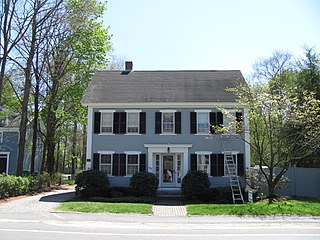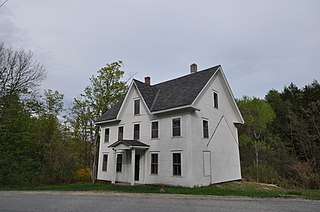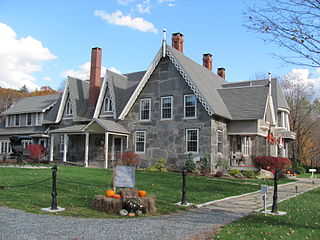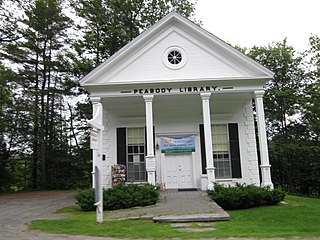
The Inness–Fitts House and Studio is a historic house at 406 Main Street in Medfield, Massachusetts. Built in 1836, it is a modest transitional Federal-Greek Revival structure. Southeast of the house stands a barn, probably built in the mid-18th century, which was adapted c. 1860 by artist George Inness for use as a studio. Inness lived here from 1860 to 1864. The property was listed on the National Register of Historic Places in 2002.

The Amelia Stewart House, also known as the Carol O. Wilkinson House and William Hallett House, is a historic residence in Mobile, Alabama, United States. It was built in 1835, with a significant Greek Revival style addition to the front built in 1871. The house was placed on the National Register of Historic Places on May 29, 1992, based on its architectural significance.

The First Congregational Church and Meetinghouse, also known as the Church of Christ and the Townshend Church, is a historic church at 34 Common Road in Townshend, Vermont. Built in 1790 and restyled in 1840, it is one of the oldest church buildings in continuous use in the state. The building was listed on the National Register of Historic Places in 2002; the congregation was established in 1777, and is affiliated with the United Church of Christ.

The Oak Hill Cemetery Chapel is a historic chapel, located in the Oak Hill Cemetery off Pleasant Street in Bellows Falls, Vermont. Built about 1885, it is one of a small number of 19th-century cemetery chapels in the state, and is the most modestly decorated of those, with vernacular Gothic Revival elements. The building was listed on the National Register of Historic Places in 1991.

The East Village Meetinghouse, also known as the Old Brick Church, is a historic church at 55 Vermont Route 14 in East Montpelier, Vermont. Built in 1833-34, it is a fine local example of Greek Revival architecture, and has been the focal point of the historic East Village for most of its history. It was listed on the National Register of Historic Places in 1980.

The Acre is a historic house at the corner of Main Street and Dublin Road in Harrisville, New Hampshire. Built about 1880 by the Cheshire Mill Company, it is a good example of period worker housing constructed by the company for itinerant workers. The house was listed on the National Register of Historic Places in 1988.

The Grafton District Schoolhouse No. 2, also known locally as the Old Fire Station, is a historic civic building at 217 Main Street in Grafton, Vermont. Built about 1835, it has served as a school, fire station, Masonic hall, tin shop, undertaker's shop, and as the clubhouse of a local brass band. Despite some alteration, it is a well-preserved example of a mid-19th century Greek Revival schoolhouse. It was listed on the National Register of Historic Places in 2005.

Milldean and the Alexander-Davis House, also known as Eaglebrook and the Eagle Hotel, are a pair of historic houses on Main Street in the village center of Grafton, Vermont. Built c. 1826 and c. 1831, the two houses are statewide rare examples of a transitional Federal-Greek Revival style executed in brick. They are also historically significant for their association with Grafton's textile trade, which was economically important in the mid-19th century. The houses were listed on the National Register of Historic Places in 1990.

North Chatham Historic District is a historic district consisting of most or all of the hamlet of North Chatham in Columbia County, New York. It was listed on the National Register of Historic Places in 2023.

The Augustus and Laura Blaisdell House is a historic house at 517 Depot Street in Chester, Vermont. Built in 1868 for a local businessman, it is a fine local example of transitional Greek Revival-Italianate architecture. It has historically served both commercial and residential functions, and now contains apartments. It was listed on the National Register of Historic Places in 2014.

Glimmerstone is a historic mansion house on Vermont Route 131, west of the village center of Cavendish, Vermont. Built 1844–47, it is a distinctive example of Gothic Revival architecture, built using a regional construction style called "snecked ashlar" out of locally quarried stone flecked with mica. The house was listed on the National Register of Historic Places in 1978.

The Stockbridge Common Historic District encompasses the central portion of a rural 19th-century village center in Stockbridge, Vermont. Including the town common as well as a few buildings and an adjacent cemetery, it is a well-preserved example of a village bypassed by economic development during the 19th century industrial period. It was listed on the National Register of Historic Places in 1990.

The Marvin Newton House is a historic house museum on Ridge Road in the Brookfield Center village of Brookfield, Vermont. Built about 1835, it is a fine example of vernacular late Federal period architecture. It was given to the local historical society by descendants of Marvin Newton, the likely builder, in 1937, and has been a museum property since them. It is open on limited weekends during summer months. It was listed on the National Register of Historic Places in 1980.

The Peabody Library is one of two public libraries buildings in Thetford, Vermont, USA. Serving the village of Post Mills, it was built in 1867, and is the oldest active library in the state federation of public libraries. It was listed on the National Register of Historic Places in 1984.

The John Wilder House is a historic house on Lawrence Hill Road in the village center of Weston, Vermont. Built in 1827 for a prominent local politician, it is a distinctive example of transitional Federal-Greek Revival architecture in brick. Some of its interior walls are adorned with stencilwork attributed to Moses Eaton. The house was listed on the National Register of Historic Places in 1983.

The District No. 8 School, also known locally as the Brick School, is a historic school building on United States Route 7 in Georgia, Vermont. Built in 1891, it was one of the last district schools to be built in the state, which mandated town control over schools the following year. It now houses the collection of the Georgia Historical Society and is known as the Brick Schoolhouse Museum. It was listed on the National Register of Historic Places in 1998.

The Warren Village Historic District encompasses the village center of Warren, Vermont, United States. Stretched mainly along Main Street east of the Mad River, it is a well-preserved 19th-century mill village, although most of its period mill infrastructure has been lost. The district has good examples of Greek Revival, Italianate, and Second Empire architecture. It was listed on the National Register of Historic Places in 1992.

The Lee Tracy House is a historic house on United States Route 7 in the village center of Shelburne, Vermont. Built in 1875, it is one of a small number of brick houses built in the town in the late 19th century, and is architecturally a distinctive vernacular blend of Gothic and Italianate styles. It was listed on the National Register of Historic Places in 1983.

The William Hayden House is a historic house on Vermont Route 14 in southern Albany, Vermont. Built in 1854, it is a remarkably sophisticated example of Greek Revival architecture in brick for a small rural community. It was listed on the National Register of Historic Places in 1978.

Stannard Town Hall is the center of municipal government of the small rural community of Stannard, Vermont. It is on Stannard Mountain Road, in what was formerly the Stannard Schoolhouse, one of the only municipal buildings in the town. Of uncertain construction, it served as a school until 1964. It was listed on the National Register of Historic Places in 1977.






















